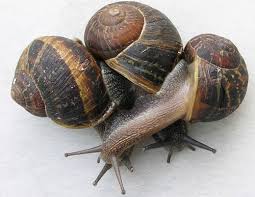In North Africa, there are prehistoric sites of thousands of empty snail shells in large heaps of tens of meters long ("escargotières", snaileries). They are that long on our menu. To collect them you therefore not necessarily have to be a fast hunter.
 Little snails are interesting for consumption. Culinary, the water snails common (peri)winkle (Littorina littorea) and common whelk (Buccinum undatum) are used, and the land snails from the family of the Achatina (giant snails to 20 cm long and weighing up to 250 grams) and Helix (snails and the like). They have little flavor of their own, hence the mostly spicy preparations.
Little snails are interesting for consumption. Culinary, the water snails common (peri)winkle (Littorina littorea) and common whelk (Buccinum undatum) are used, and the land snails from the family of the Achatina (giant snails to 20 cm long and weighing up to 250 grams) and Helix (snails and the like). They have little flavor of their own, hence the mostly spicy preparations.
The Burgundy -, Roman -, edible snail or escargot snail (Helix pomatia) is sometimes confused with the (Brown) Garden Snail (Cornu aspersum, also Cryptomphalus a. And Helix a.) which is much smaller and has a cottage which is darker brown, with a more pronounced stain drawing. (For juveniles it is difficult to tell the difference.) The body of the Brown Garden Snail is also much darker. The Garden Snail is also called Petit gris or caracole (as distinguished from the (protected) larger Burgundy snail.
The shell is convex-conical with a blunt tip, slightly wider than tall, and has up to five growing windings, separated by a shallow structure. She is irregular and rough striped towards the growth lines (lines perpendicular to the turn of the cottage).
For wintering the snail seal her house with an amorphous and hard, gray calcareous epifragma.
The snail comes from the south and southwest Europe. Elsewhere, she is a successful exotic species. through young plants and transports they now live in most of Europe, including the Netherlands and Belgium. She loves warm and moist, and her cottage also needs an environment with calcium.
They eat young green plants or shoots.
They are mostly active at night because it is more humid then. Even after the rain during the day they come out en masse.
To gather in nature you should consider pesticides (railway embankments!) and the use of fertilizer. Garden snail can be grown both outside in fenced parks as inside under fully controlled conditions. A by-product, the snail eggs are also called white caviar.
You give them chlorophyll from garden and kitchen waste, as long as it is not toxic to humans: peel of zucchini, cucumber, lettuce and especially cabbage.
The adult garden snails have a shell diameter of about 30 mm and weight, including shell 8 to 15 grams. After the greens you give them three days in an airy wicker basket with a saucer of flour, possibly mixed with some (dried) herbs and a pinch of salt, and a dish with some water. Then remove food and drink and let the snail fasting for three days.
Then all snails are carefully degummed by repeatedly washing and rinsing them in water with salt and vinegar. Then you can prepare them as snails (see <escargot>). The classic French recipe includes garlic butter with garlic and parsley. You can also sterilize and store them in glass jars in a court-bouillon and herbal.
If you choose a death that seems calmer you can also freeze them first for a day.
